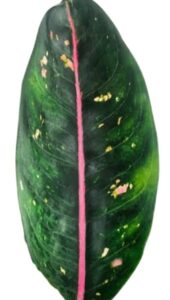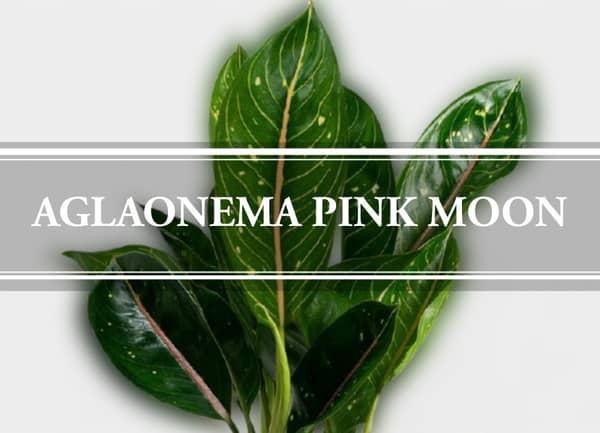Are you looking for a small, low-maintenance plant with tolerance for different light levels? Say hello to the Aglaonema Pink Moon! The height of these compact growers remains around 2 feet, making them suitable for beautifying congested places. The central vein of the long dark-green leaves is prominently pink.
Additionally, these fleshy thick, and glossy leaves are covered with splashes of pinkish-white variegation. Sounds cool, right? You can grow them in any corner of your home, office, patio, or outdoor yards. Above all, these Asian native plants are happy to grow without demanding much of your efforts. Still with us? Let us share a summarized guide about the care and maintenance of the Pink Moon Chinese Evergreen Plant.
Aglaonema Pink Moon Classification
Family: Araceae
Genus: Aglaonemateae
Cultivar: Pink Moon
Genus Aglaonemateae:
It is an Aroid genus of flowering plants. They belong to the tropical and sub-tropical areas of Asia and New Guinea. These evergreen plants are quite popular in Chinese culture. Moreover, they have been a sign of positivity and good luck since ancient times.
Chinese evergreen plant is the common name for all the members of the genus. The bright and beautiful foliage and easy-to-care nature make the majority of them suitable for indoor ornamental plantation.
Features of the Aglaonema Pink Moon Plant

Size
The plant forms a small compact shrub growing up to 1 to 2 feet on maturity.
Leaves
The bold and prominent leaves are the main feature of the plant. A mature leaf may get almost equal to half or the 2/3rd of the total length of the plant.
Flower
Just like all the sibling plants, this one too produces pinkish-white Lilly-like flowers. Also, these flowers are commonly seen in the warm days of spring and summer.
Air-purification
The Pink Moon plant and its siblings provide air-purifying benefits. They remove toxins like Benzene and Formaldehyde from the air.
Toxicity
All the members contain crystals of calcium oxalate. This makes them toxic for both humans and pets. Ingestion can lead to ulceration in the mouth and issues like nausea and diarrhea.
Hence keep the plant away from kids and pets. Also, get immediate medical help in case of emergency.
Aglaonema Pink Moon Care
All the members of the genus are quite easy to care.
Quick Guide:
Water: Moderat (After the upper half of soil gets dry)
Sun: Indirect sun and fluorescent light.
Humidity: Loves high but can tolerate lower levels.
Fertilizer: Mild concentration in spring and summer.
Let us learn the details about “How to grow the Pink Moon Aglaonema Plant?”
Water Requirement
The plant needs frequent watering on warm days. Water the soil thoroughly and wait for the upper half to get dry before watering again. Make sure the soil does not remain wet or soggy. The reason being, it suffocates the roots causing root rot. Furthermore, over-watering, it goes unnoticed, can even kill the plant. In short, moderation is your key to the watering strategy. Avoid over-watering in the same way you avoid drying out the plant.
Now, we are coming towards the frequency of watering. It depends on different features like sunlight, temperature, and humidity. It is usually enough to water about once or twice a week for the spring and summer seasons.
The cold temperature of fall and winter decreases the activity and water requirement of the plant. Thus, watering it about once every two to three weeks is enough for the colder days.
Light Requirement
The Aglaonema Pink Moon plant loves to be in bright indirect sun. Meanwhile, it can tolerate different levels including low light to shade.
The ideal place while planting outdoor is a shade with plenty of bright sun around. You can follow the same strategy for indoors as well. A well-lit window or a corner where the direct sun can not reach the foliage is the best for your Chinese Evergreen Plant.
In absence of sun, you can count on fluorescent light also. Just make sure the plant is at least 6 feet away from the light source. Talking about the direct sun! Avoid it for the plant as it can scorch out or even kill the delicate foliage.
Temperature Requirement
These peeps love to stay in warmth. The ideal temperature for all the members of the genus ranges between 65 to 80 °F.
They have poor tolerance for lower temperatures and frost. A temperature lower than 60 °F may cause issues like dark patches on the foliage. Moreover, it may even freeze and kill the plant. Thus, don’t forget to bring the outdoor ones to some warm indoor spot.
Humidity Requirement
These tropical and sub-tropical natives naturally love to be in high humidity. A moisture level of around 70% ensures healthy and lush foliage. However, they show tolerance for lower levels surviving well in dry weather.
In colder regions, the indoor peeps may need a little pampering to avoid drying up. The heating systems usually lower the humidity of the room. Thus, you have to ensure an adequate moisture level.
You can use any of the popular methods to increase humidity. These methods include using a pebble-water tray, a room humidifier, or grouping the plants. Moreover, you can also give a weekly or bi-weekly mist to the foliage. However, make sure the plant stays at a well-ventilated place. Foliage staying wet for long may invite issues like pest attacks, fungus, or leaf rot.
Soil Requirement
Just like all the family members, this one too needs well-draining soil. Go ahead with the commonly available houseplant mixture. Additionally, you can use a peat-base mixture with perlite or sand to enhance the drainage.
Fertilizer Requirements
These slow-growers love extra nutrition. Use a mild concentration of balanced fertilizer once or twice a month in spring and summer.
The growers need to be vigilant about the concentration. Experts recommend using mild, preferably half of the stated dose. This helps you avoid over-fertilizing, which can scorch out and even kill the plant.
As mentioned earlier, fall and winter result in slower growth of the plants. Consequently, nutritional requirements also decrease. Hence, stop fertilizing the plant right after the end of the summer.
Potting and Repotting Requirements
Your Aglaonema Pink Moon likes to grow slightly root-bound. Use a medium-sized pot with drainage holes at the base.
As far as repotting is concerned, you don’t need to do it for about two to three years. Some of the roots growing out from the basal holes are not an issue here.
Pinching and Pruning Requirement
Bushy plants look prettier. Want to make your Aglaonema plant bushy? Pinching will help you! Just pinch and remove some of the new leaves as they appear. You have to slightly pull the leaf from its base and take it out completely. Just make sure no leaf part or petiole is left behind.
Using a scissor is not appropriate as it does not serve the purpose of pinching. Now, coming towards pruning. Simply, cut the damaged leaves to enhance the growth and outlook of the plant.
Aglaonema Pink Moon Propagation
Are you thinking about making some more Pink Moon Aglaonema plants? All of these plants are quite easy to propagate with more than 50 hybrid cultivars in the genus. You can propagate them by methods like stem-cuttings and root-division.
Season:
Middle of the spring until the middle of the summer is the ideal time for propagation.
Propagation by Root-division:
This is the most popular method resulting in exact replicas of the cultivar.
- Select a well-grown plant and lose the soil around it. Take it out of the pot and the soil very gently without damaging the root ball.
- Take a sterilized pair of gardening shears. Cut about 1/3rd of the plant along with the roots and the shoots.
- Plant both of the divided parts in their prepared places.
- Place the pots in indirect sun. Additionally, moisten the soil with mild spraying every week to retain the moisture. The new plantlets will take about 2 to 3 months to get their roots settled in the new place.
Propagation by Stem-cuttings:
- Cut a 5 to 8 inches stem from the plant. The cutting should be from an old stem or a new shoot bearing at least 5 leaves.
- Remove the leaves from the lower ends while keeping at least 2 on the upper side.
- Plant the cuttings about 3 inches deep in moist well-drained soil.
- Place the setup in indirect sun and water mildly about once a week.
- These cuttings will develop roots in a matter of about 3 to 4 weeks. After this, you will eventually see the development of new shoots around the 6th
Propagation in water:
The stem cuttings can root in water as well. Just don’t forget to provide indirect light and change the water every week.
- The water planted cuttings take slightly longer to root as compared to the ones in the soil. Wait for about 6 to 7 weeks until you see the initial development.
- Furthermore, the rooting system will develop and you can plant these cuttings in the soil after about 2 months.
Related Post:
Summary
Aglaonema Pink Moon is an Asian native Aroid cultivar. This compact bushy plant can get about 2 feet tall. The long dark-green fleshy leaves with pinkish-white splashes have a prominent pink shade in the central vein. The plant has a tendency to tolerate different levels of indirect light including shade and low light.
This makes it an ideal choice for homes and offices. Moreover, you can also grow them outdoors but in moderate climates. Apart from being beautiful low-maintenance air-purifying plants, these peeps are toxic. Keep kids and pets away from your Chinese Evergreen Pink Moon Plant.

